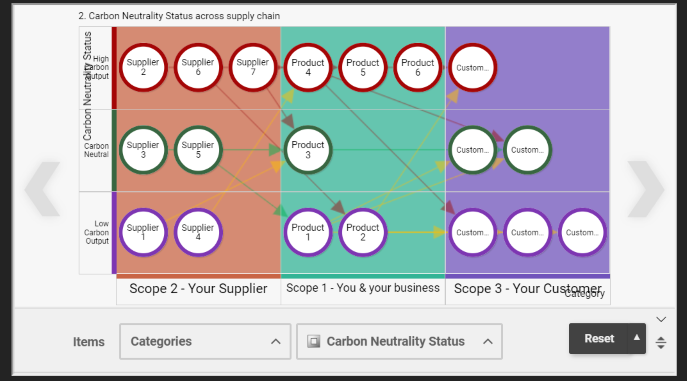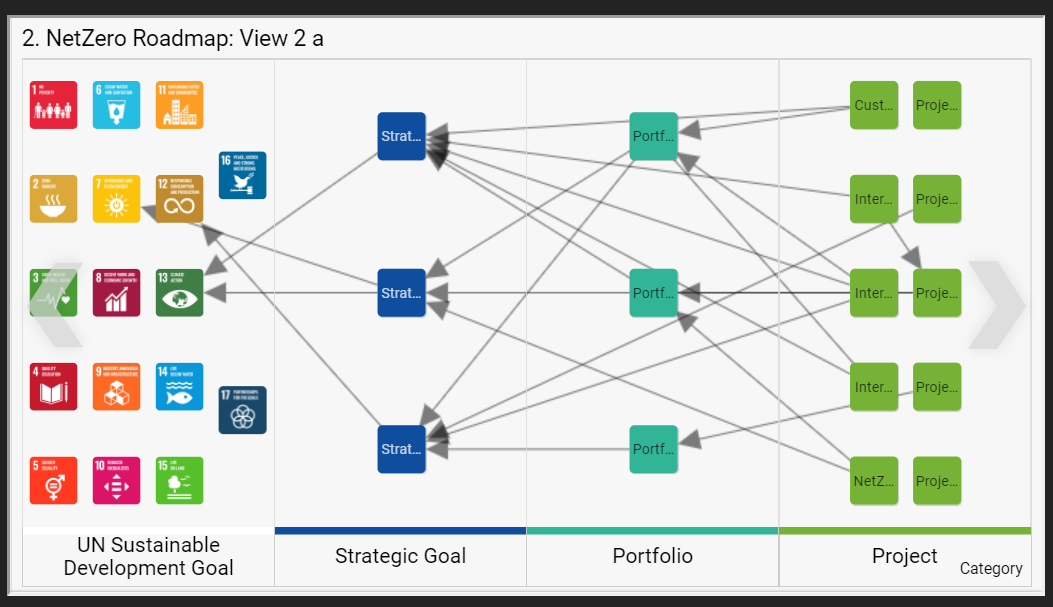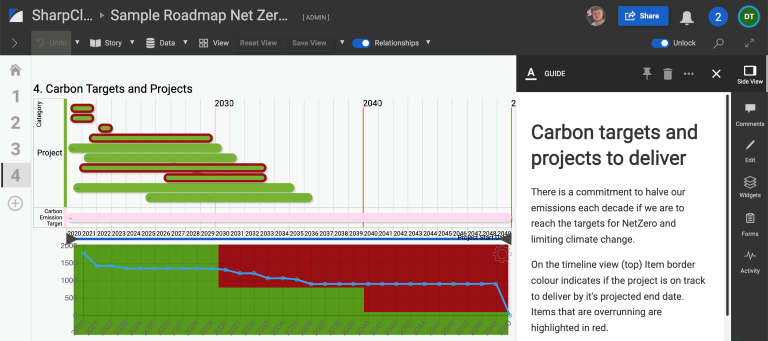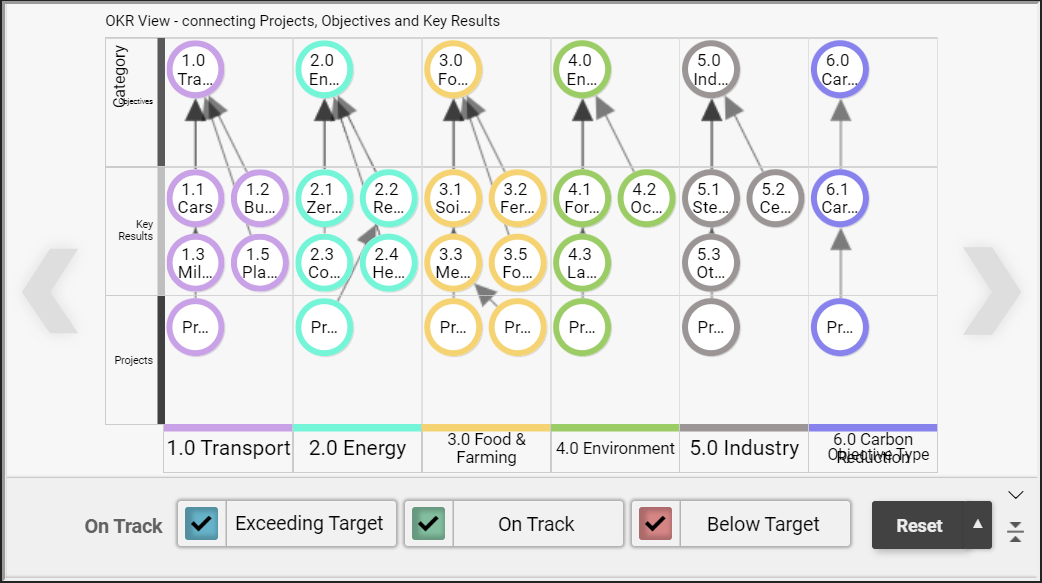Organizations globally are facing challenges around working towards their carbon neutral goals - missed quarterly targets are just the beginning of a failed sustainability strategy. One way to challenge this is through converting your long-term strategic plan for carbon goals from a static spreadsheet into a dynamic roadmap.
A company’s environmental impact is measured by the total amount of greenhouse gas emissions associated with its activities, including its supply chain. This is known as its carbon footprint. The higher the emissions, the larger the carbon footprint, and the more damage done to the environment.
What is carbon neutrality and why pursue it?
Carbon neutrality is achieved by calculating a carbon footprint and reducing it to zero through a combination of efficiency measures in-house and supporting external emission reduction projects.
There is an increasing number of businesses claiming to be carbon neutral. They recognize that being carbon neutral can play a key part of their sustainability and Corporate and Social Responsibility (CSR) strategy whilst enabling them to do their bit for global climate change.
They also recognize that individuals and corporate customers want to make a difference to their own carbon footprint and prefer to buy products and services from climate conscious suppliers.
Having a carbon neutral goal helps engage both your customers and your stakeholders, proving you have a long-term vision for your company and helping to improve your reputation.
Challenges of a carbon-neutral supply chain
Supply chains matter. A need for a carbon-neutral supply chain comes from the understanding that climate change will affect the future of the whole supply chain, right from sourcing raw materials to the use of the final products.
It's vital to understand your supply chain to ensure suppliers are heading towards the same 'Net Zero Objectives' as you. One of the trickiest aspects of transforming the supply chain into a carbon-neutral one is correctly identifying where in the supply chain the carbon emissions come from and how best to direct carbon-neutralising efforts.
Supply chains have been notoriously opaque in the past but now, thanks to technology, artificial intelligence and analytics can help track and analyze this information providing more transparency.
SharpCloud Net Zero Solution example for Supply Chain Neutrality

How to embark on becoming carbon neutral
Going carbon neutral doesn’t happen overnight. When attempting to pursue carbon neutrality, some emissions are unavoidable, but once a company knows its carbon footprint, it can begin to work to offset it.
Roadmapping software is used to help organizations understand and align their long-term business goals. A powerful roadmapping tool can help you to visualize and understand:
- The current status of your carbon footprint
- The defined goal (carbon neutrality) your team is striving towards
- How you will get there as well as managing the whole process
Businesses need an agile and transparent framework to communicate and deliver carbon neutrality for their business, products and/or activities.

By building a viable roadmap demonstrating your carbon neutral goal, you can then think about a systematic approach to achieving it:
-
Set your carbon neutrality and carbon management strategies
-
Calculate and track your carbon footprint
-
Implement cost effective carbon reduction programmes
-
Offset emissions through a wide choice of high quality projects around the world
-
Develop your marketing and communications strategy around their environmental credentials
- Encourage transparency in your supply chain and consistently evaluate how close or how far they are from their carbon emission goals
The EU aims to be carbon neutral by 2050 and many organizations are building roadmaps to try and meet that deadline. With such a lengthy period of time allowed, tracking your progress is key. A dynamic roadmap could help communicate progress internally with stakeholders and c-suite executives, but also with customers externally.

How to manage your carbon neutrality roadmaps
Deeper cooperation
Firstly, creating a roadmap is an inherently collaborative process. Roadmaps are often created through collaborative workshops, allowing the map to incorporate input from across your business.
Not only does this generate a wellspring of collective knowledge, it also allows your team members to better understand the role they play within the organization's bigger picture. This can boost your team’s morale and strengthen their commitment to reaching your shared carbon neutral goals.
Develop your plan in real-time
Modern roadmapping software will also allow your team-mates to continue the collaboration process after strategy planning sessions end, commenting on and adjusting plans in real-time. This collective effort will ensure that everyone is on the same page, inspired, and focused on working towards your desired outcome.
Increased flexibility
Roadmaps also have the added benefit of being dynamic in nature. They constantly develop as new ideas or potential challenges and risks are integrated into the plan. In this way, roadmaps can be hugely flexible – quite the opposite of the immobile planning documents of the past.
No matter what internal or external changes come your way, if your plan has been roadmapped effectively you’ll be able to adjust to these changes and avoid making costly mistakes.
Visually engaging
Another primary advantage of using roadmaps is their ability to present complex, multi-layered plans and data in a way that is easy to understand and visually captivating.

Great roadmapping software will allow you to delve deeper into different elements of your plan and identify and assess the relationships between them, giving you a more comprehensive understanding of the thought process that has gone into each stage. In this way, roadmaps turn confusing data into a vivid and cohesive story.
Greater collaboration
Once the roadmap is visible, it may spark open conversations between stakeholders, resulting in a more collaborative organizational culture. SharpCloud dynamically updates data in real-time, improving collaboration and ensuring your presentations are always showing the latest facts and figures. Stakeholders gain a visual tool to see how a project is progressing and understand quickly how changes can impact the business.
Supply chain collaboration
Organizations are only as strong as the weakest link in their sustainability chain. Using a collaborative roadmapping tool will enable you to work with suppliers, customers and each other to identify risks, unlock opportunities and track progress.
Net Zero templates designed to help you
SharpCloud has a selection of 'Net Zero Solutions' especially designed for Net Zero Objectives. From building your knowledge of your supply chain scope and net zero compliance, to defining how your net zero strategic priorities will reach your organisation, we have solutions to help you with gap analysis, cost/benefit analysis as well as capturing, monitoring and measuring your performance against your objectives and key results.
Best strategic roadmapping tool
Today, businesses want to manage and communicate their vision from a single tool. SharpCloud's dynamic software is a modern roadmapping and decision empowerment tool that offers real-time changes, meaning you don't waste any time or decisions, when communicating your carbon neutral plan to stakeholders and c-suite executives.
Features in SharpCloud for Roadmapping
SharpCloud is packed full of features to help create interactive roadmaps, collaborate with data, and communicate engaging visual stories.
- Net zero templates to get you up and running fast
-
View data from multiple dimensions for portfolio analysis
-
Visualize relationships, interdependencies, and understand complexity
-
Filter data, reduce noise and gain clarity
- Edit data visually and work with multiple data sources

